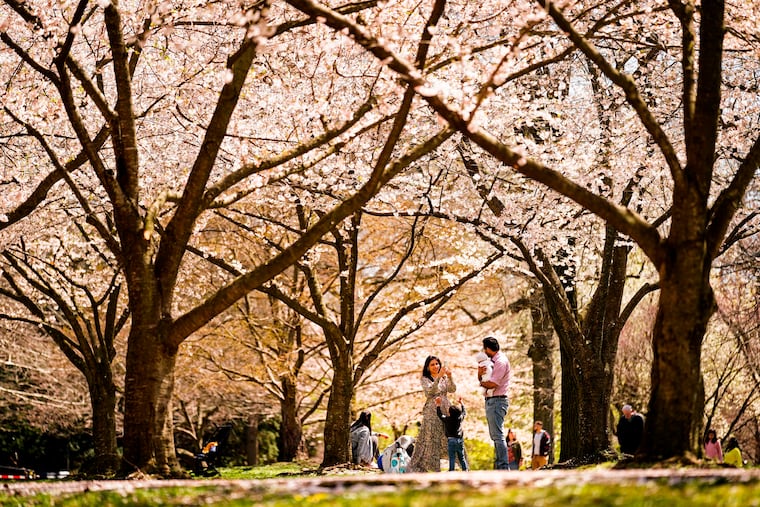Philly to hire its first city forester, and plant thousands of trees over the next decade
The plan would cost $25 million a year to carry out with a key goal of making areas of the city's heat island neighborhoods cooler.

The first Philly Tree Plan released Thursday by Philadelphia’s Parks and Recreation calls for planting thousands of trees over a decade to increase the city’s canopy to 30% — and hiring the first city forester along with support staff to ensure the trees thrive.
The 128-page plan, which took several years to put together, would cost $25 million annually with a key goal of protecting existing trees and planting new ones, especially in impoverished communities that can experience temperatures 22 degrees higher than in other neighborhoods because of a lack of shade.
Trees also beautify, filter pollution, store carbon, provide habitat for wildlife, and boost the health of residents as green space through their canopy, which is the area covered by branches and leaves when viewed from above, the plan notes.
But its authors acknowledge that trees can cause headaches by lifting up sidewalks, clogging small streets with leaves, and requiring expensive maintenance.
As a result, the plan recommends hiring a “sidewalk coordinator,” street tree inspectors, and additional parks and recreation staff to not only plant and care for trees, but to keep up with thousands of tree-related calls made each year to 311, the city’s residential service line.
Officials say there is federal, state, and local money available, as well as a new Philly Tree Fund to pay for it. Under a new city law, developers who remove trees on lots greater than 5,000 square feet must either replace all trees or pay a fee that goes into the fund.
The city budget has allocated $2 million toward the plan for this year, and millions more are expected from the federal Inflation Reduction Act.
Erica Smith Fichman, Parks and Rec’s community forestry manager who led the plan, said that it might take time to hire the forester, but that officials are ready to move quickly on other positions.
“We do have 15 other positions that we are ready to begin hiring for that span everything from increasing customer service to increasing our community organizing staff to building our natural lands crews and more,” Fichman said.
Troubling trend
Officials say the plan would reverse a distressing trend: The city’s canopy shrunk by 6% between 2008 and 2018 — the equivalent of 1,000 football fields. Though losses were citywide, losses were bigger in some neighborhoods such as Lawndale, Crescentville, Frankford, and Oxford Circle.
About 20% of the city is covered by canopy. But some neighborhoods have as little as 5% while others have 45% or more. This story has been updated to reflect that the city has 117,000 street trees, as well as trees spread across 10,000 acres of park land.
“Healthy trees are an important part of safe, healthy, and thriving communities,” Philadelphia Parks and Recreation Commissioner Kathryn Ott Lovell said. “This plan uplifts our urban forest by properly funding the care and maintenance of the trees that line our residential streets and the public right of way.”
Areas with less canopy experience higher average temperatures, and residents tend to have lower physical and mental health outcomes, data show. They are often in neighborhoods experiencing poverty, and where planting and caring for trees would be an additional burden. So trees would be planted on a large scale in priority areas and the forester would establish programs to help residents care for saplings.
About 7,000 people responded to a survey conducted for the plan, and 847 residents attended 32 community meetings. City agencies, local schools, the Pennsylvania Horticultural Society, Morris Arboretum, Penn State, Fairmount Park Conservancy, University of Pennsylvania, and state and federal officials all had input into the plan. And dozens of community leaders sat on a key committee.
Impediments
Street trees planted along sidewalks and medians account for 10% of the city’s canopy.
“Trees can be a burden on homeowners, outweighing the benefit,” the plans states, noting the city hasn’t done a great job of maintaining existing trees, which grow in vacant lots and alleys, sometimes resulting in property damage and safety issues.
Neighborhoods such as Kensington, Fishtown, Harrowgate, Manayunk, and Tacony remain challenging places to plant trees because they were designed to cram in as much housing as possible during the city’s industrial past, the plan states. And neighborhoods that drew African Americans during the Great Migration still have some of the fewest trees.
Types of trees
New staff would figure out what types of trees should be planted and where, while prioritizing native species. Staff would also have to find ways of caring for new trees within the first critical years.
Many residents suggested that food-bearing trees be planted to address food deserts and as a way to connect people with their cultures and histories. But the plan notes that it takes years for trees to produce fruits and nuts, often requiring a generational effort.
Officials also recognize that branches and roots can bump up against utilities. So the plan calls for staff to work with utility companies. It suggests burying power lines on wide streets and commercial corridors to allow tall trees to prosper.
Read the full Philly Tree Plan:
This story has been updated to reflect that the city has 117,000 street trees, as well as trees spread across 10,000 acres of park land.